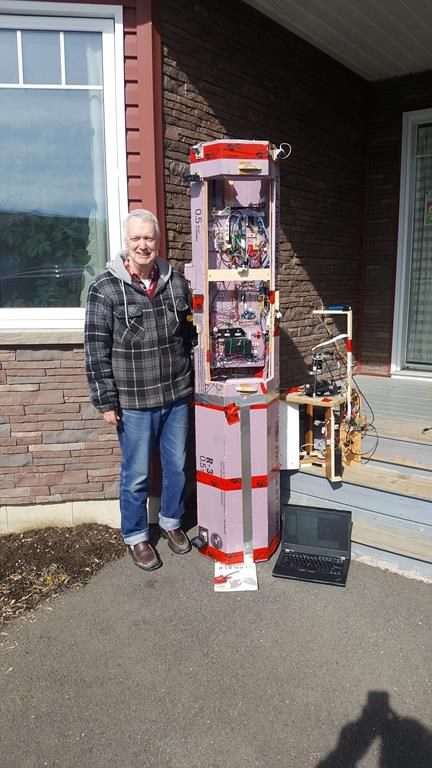In the coming days, many Canadians will look up to see a total solar eclipse, but some may be let down by cloudy skies.
David Hunter, a retired medical physicist in western New Brunswick, has led a team of volunteers to create a sun-tracking telescope that will be lifted by a weather balloon on April 8.
Hunter explained that the main aim is to rise above any cloud cover, and the helium-filled balloon could reach heights of up to 30 kilometers above the Earth after its launch from Florenceville-Bristol, N.B., at 3:30 p.m. Atlantic daylight time.
As it goes up, the balloon will carry a 2.3-meter tube-shaped box with small computers, four tracking devices, and multiple cameras, some of which will send images to a ground station at the Florenceville Inn.
The footage will then be livestreamed to various viewing spots in western New Brunswick, as well as a YouTube channel, with the link to be posted on Hunter’s website soon.
The moon’s 185-kilometer-wide shadow will reach Florenceville-Bristol at 4:32 p.m. ADT, causing brief darkness. Only then will it be safe to look at the sun without eye protection.
If there is minimal cloud cover, the sun’s rays will vanish into twilight, giving way to stars and planets, with the horizon taking on an orange glow like at sunset. This will reveal the sun’s delicate corona peeking out from behind the moon, an otherworldly sight typically concealed by daylight.
The temperature is expected to drop around 5 degrees Celsius, and nearby animals may behave unusually. The eclipse will be brief, as the moon’s shadow races eastward at about 3,700 kilometers per hour.
Hunter noted that the greatest technical challenge his team faced was creating a mechanism to enable the telescope to consistently track the sun as the balloon’s eight-kilogram payload moves in the wind.
“It spins, but it also bobs and weaves,” Hunter mentioned, adding that University of New Brunswick students also contributed to the project. “This has been the most difficult part … I was told it was impossible.”
Using technology developed at Université Laval in Quebec City, Hunter and his team developed their own version of a gimbal mechanism called the “Agile Eye.” Instead of pointing the flying telescope at the sun, it is directed downward at a mirror connected to two computerized control motors.
“The mirror moves to ensure it always directs the sun into the telescope,” Hunter stated.
Experiencing solar eclipses has been a lifelong passion for Hunter. As a boy in Florenceville, he witnessed his first eclipse in 1963, sparked by his interest in the solar system and the universe from a series of “How and Why Wonder Books.”
“Seeing the images of galaxies and, especially, the Orion nebula, I thought, ‘Oh my heavens, that’s beautiful.'”
He constructed a telescope from a set of parts, and in March 1970 he journeyed to Nova Scotia with his family to observe a complete solar eclipse.
“It was overcast,” he said with a sigh. “It was such a feeling of helplessness. That was my initial experience with being blocked out by clouds during an eclipse.”
As a grown-up, Hunter worked in Toronto on digital imaging techniques for breast cancer screening. But his interest in cosmology never decreased. “When I retired, I thought that if I moved back to New Brunswick, there’s open space,” he said. “You can actually see stuff in the sky, which is not so easy in Toronto.”
And when he learned that the 2024 solar eclipse would see the moon’s shadow pass directly over his hometown, he thought, “I don’t want to be clouded out again.”
Meanwhile, the prevailing westerly winds are expected to carry the balloon along the moon’s projected path, but that’s not a sure thing. “We have no directional control over where it is going,” Hunter said. “We’re at the mercy of the winds.”
Still, Hunter said a November test flight went off without a hitch. As the balloon neared the Gulf of St. Lawrence on New Brunswick’s east coast, a signal from the ground station instructed an on-board computer to sever the rope between the balloon and its payload. The payload dropped safely to the ground, a parachute slowing its descent.
Despite their cosmic mystique, total solar eclipses aren’t rare. They appear once or twice every year somewhere on the planet, according to NASA. Most locations typically wait between 400 and 1,000 years for a repeat performance. The last time a total solar eclipse passed through the area now known as central New Brunswick was AD 982, Hunter said.
Nova Scotia, by contrast, has been relatively spoiled, experiencing total solar eclipses in 1970 and again in 1972. And next month’s eclipse will also track across the northern tip of Cape Breton. Since 1963, Canadians have witnessed five total solar eclipses, though the one in 2008 tracked across the upper reaches of the Arctic.
This report by The Canadian Press was first published March 10, 2024.



